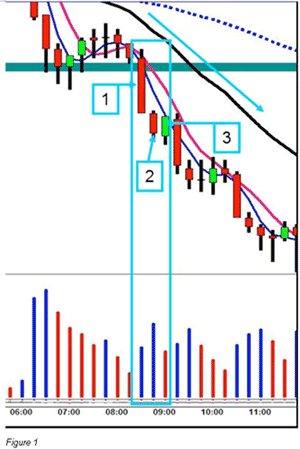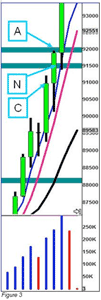Many types of set-ups are available to today's stock index, commodities, and currency traders. Some are breakout; and some are trend, countertrend. Today's three-bar breakout (3BB) set-up article will focus on the breakout strategies of key support and resistance levels.
The Strategy
The underlying success and strategy behind the 3BB set-up is that it helps avoid the false breakout syndrome that so many traders and investors get sucked into each day as their greed and emotions take over. This typically happens when a market has consolidated for a period of time and there is a one-bar false move through a key support or resistance level prior to the real move beginning. By the nature of the set-up, this strategy also allows for a pause to refresh, and a reduction of the chance for a trader to be stopped out during a pullback before the trend resumes in the direction the trader properly identified originally.
The Set-up
This article describes the more conservative version of a set-up that traders use in my trading community. The conservative set-up consists of the following key elements (See Figure 1.):
- Bar 1: Rising volume and a break through a key support or resistance level
- Bar 2: Additional rising volume over bar 1 and a closing price beyond bar 1
- Bar 3: Pullback to a support or resistance level in the direction of the trend you are trading on lighter volume than the volume from the second bar.
Note: It's critical that the 20-period exponential moving average is trending in the direction of the proposed trade. For example, a trader should only be looking to take a long position if the 20-period exponential moving average is trending up. A trader should only look to take a short position if the 20-period exponential moving average is trending down. If the 20-period exponential moving average is trending sideways, AKA a choppy market, the trader should step aside and not trade in that environment with this set-up.
“No Trade” Zones
Over the years, every successful trader has come to develop times and circumstances not to be trading in the market. The following are examples of times and conditions that I will generally not trade due to the extreme volatility and unreliability of technical patterns under those circumstances.
- Before 3 am ET
- Near any economic data releases in the United States (i.e. home sales, jobless claims, etc.)
- Near the opening bell (9:30 am ET)
- Near noteworthy speaking engagements (i.e. Presidential, Treasury secretary, Federal Reserve chairman, or any other highly anticipated speech in the economy being covered heavily by financial news media)
- If either of the first two thrust bars of the set-up close at or near the 50% level of the bar (from high to low), this set-up should not be traded. Don't pull out a ruler. If when looking at the bar, it closes anywhere near the 50% level, do not trade the set-up.
- For conservative traders only: If the volume requirements are not met on either of the first two bars, the trade should not be taken. This does not apply to more aggressive traders. Aggressive traders have several more options available through PowerCharting.com
NEXT: Where to Place Entries in This Set-up
|pagebreak|Entries
Entries into this set-up can be taken based on one of three styles of trading, (See figure 2.) For the conservative trader, on the fourth bar, one can enter on the pass back through the opening price after a short turn countertrend fakeout traps overambitious countertrend traders prior to the trend resuming itself in the direction of the original two thrust bars.
For the average trader, the normal entry will be to enter on the close of the third bar.
For the aggressive trader, they have the option to enter on the close of the second thrust bar with the understanding that there could be a significant pullback prior to trend resumption.
Stops
As it relates to stops, first and foremost, stops should be placed according to the parameters that you and your registered financial representative have set forth. This should also be based on an appropriate risk/reward ratio. For instance, you should not be risking five or ten points in order to make one or two points.
Additionally, from a technical perspective, if your trade moves against you and closes above or below the 20-period exponential moving average in the opposite direction of your trade, that is also a solid indication that the trend characteristics may be changing and it is time for you to exit your trade and observe the market for verification of a trend change.
Exits
Exits from this set-up can be taken based on one of three styles of trading (See Figure 3.). For the conservative trader (denoted as "C" in figure 3.), exiting on the close of the fourth bar provides you the opportunity to earn income yet minimize your time exposure to the market.
For the average trader (denoted as "N" in figure 3.), exiting your entire position at or near the next key support or resistance level is an opportunity to let your trade run beyond the close of the fourth bar yet lock in profits from the trade at or near the same point where countertrend traders and other traders looking to lock in profits will do so.
For the aggressive trader (denoted as "A" in figure 3.), there is an opportunity to exit at least half of your position at the next key support or resistance level and let the remainder of the position make an attempt to run to the next support or resistance level beyond the first. However, you should only do so after moving your stop up to breakeven, thus allowing you to lock in profits yet let your winners run and give them the opportunity to provide you with greater gains while ensuring your ability to walk away with a profit after moving your stop up to breakeven on the remaining half.
The 3BB technique is one that provides a higher-probability entry than traditional "buy the break" methodologies that often quickly reverse. It can be used in most markets with the only modification needing to be made in those that don't provide volume data, which require the usage of more aggressive techniques. There are also several other opportunities for more aggressive traders pertaining to this set-up.
By Robert Hoffman of PowerCharting.com
Please visit www.powercharting.com for further information in how to join our free intraday chat room to learn more about those aggressive trading styles that cannot be thoroughly discussed in today's article.
Robert Hoffman is the president of PowerCharting.com and a 15+ year veteran of the financial markets. He educates thousands of individual and professional traders and investors from around the world on a daily basis with his work. He has also been an affiliate member of the Market Technicians Association since 1998, an organization dedicated to the highest standards in technical analysis. Robert was recently a featured speaker at the International Traders Expo in Las Vegas and will also be doing a live two-hour trading session at the upcoming Traders Expo in New York in February.




















